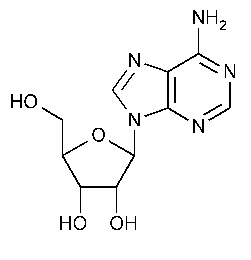Adenosine
»Adenosine contains not less than 99.0percent and not more than 101.0percent of C10H13N5O4,calculated on the dried basis.
Packaging and storage—
Preserve in tight,light-resistant containers,and store at controlled room temperature.
Identification,Infrared Absorption á197Mñ.
Specific rotation á781Sñ:
between -68.0 and -72.0
and -72.0 .
.
Test solution:
20mg per mLin sodium hydroxide solution (1in 20),determined on a test specimen previously dried at 105 for 2hours.
for 2hours.
Acidity or alkalinity—
Suspend 1g in 20mLof carbon dioxide-free water.Stir for 30seconds,and pass through a coarse filter.To each of two 10-mLportions of the filtrate add 0.1mLof bromocresol purple TS.Not more than 0.3mLof 0.01Nsodium hydroxide is required to produce a blue-violet color in one portion,and not more than 0.1mLof 0.01Nhydrochloric acid is required to produce a yellow color in the other portion.
Loss on drying á731ñ—
Dry it at 105 for 2hours:it loses not more than 0.5%of its weight.
for 2hours:it loses not more than 0.5%of its weight.
Residue on ignition á281ñ:
not more than 0.1%.
Heavy metals,Method IIá231ñ:
0.001%.
Limit of ammonia—
Suspend 0.5g in 10mLof water.Stir for 30seconds,and pass through a coarse filter.Dilute the filtrate with water to 15mL,mix,and use the filtrate as the test solution.Dilute 1mLof ammonium chloride solution (314mg in 1000mL)with 100mLof water.Mix 2mLof this ammonia standard solution with 13mLof water,and use this as the reference solution.To the test solution and the reference solution add 0.3mLof alkaline mercuric-potassium iodide TS,cap the test tubes,and allow to stand for about 5minutes:the test solution does not exhibit a more intense yellow color than that of the reference solution (not more than 0.0004%ammonia).
Limit of chloride—
Suspend 0.2g in 10mLof water.Stir for 30seconds,pass through a coarse filter,and use the filtrate as the test solution.Prepare a chloride standard solution by diluting 1mLof sodium chloride solution (231mg in 1000mL)with 100mLof water.To the test solution and 10mLof the chloride standard solution add 1mLof nitric acid and 1mLof silver nitrate TS,dilute each solution with water to 40mL,and mix.Allow the solutions to stand for 5minutes,protected from light.When viewed against a dark background,the test solution is not more turbid than the standard solution (not more than 0.007%chloride).
Limit of sulfate—
Suspend 0.75g in 15mLof water.Stir for 30seconds,pass through a coarse filter,and use the filtrate as the test solution.Prepare a sulfate standard solution by adding 0.15mLof 0.020Nsulfuric acid to 15mLof water.To the test solution and the standard solution add 2mLof barium chloride TSand 1mLof 3Nhydrochloric acid,dilute each solution with water to 30mL,and mix.Allow the solutions to stand for 5minutes:the test solution is not more turbid than the standard solution (not more than 0.02%sulfate).
Chromatographic purity—
Sulfate buffer—
Dissolve 6.8g of potassium hydrogen sulfate and 3.4g of tetrabutylammonium hydrogen sulfate in water,dilute with water to 1000mL,and mix.Adjust with 2Npotassium hydroxide to a pHof 6.5.
Mobile phase—
Prepare a filtered and degassed mixture of Sulfate bufferand a solution (1in 10,000)of sodium azide (60:40).Make adjustments if necessary (see System Suitabilityunder Chromatography á621ñ).
System suitability solution—
Transfer about 20mg of Adenosine and 20mg of inosine,each accurately weighed,to a 100-mLvolumetric flask.Dissolve in and dilute with Mobile phaseto volume,and mix.
Test solution—
Dissolve an accurately weighed quantity of Adenosine in Mobile phase,and dilute with Mobile phaseto obtain a solution having a concentration of about 1mg per mL.
Chromatographic system (see Chromatography á621ñ)—
The liquid chromatograph is equipped with a 254-nm detector and a 4.6-mm ×25-cm column that contains 5-µm packing L1.The flow rate is about 1.5mLper minute.Chromatograph the System suitability solution,and record the peak responses as directed for Procedure:the resolution,R,between adenosine and inosine is not less than 9.0;the tailing factor is not more than 2.5;and the relative standard deviation for replicate injections is not more than 2.0%.Chromatograph the Test solution,and adjust the run time to at least twice the retention time of the major peak.
Procedure—
Inject a volume (about 20µL)of the Test solutioninto the chromatograph,record the chromatogram,and measure the peak responses.Determine the percentage of each impurity in the portion of Adenosine taken:not more than 0.1%each of guanosine,inosine,and uridine is found;not more than 0.2%of adenine is found;and not more than 0.5%of total impurities is found.
Assay—
Dissolve about 200mg of Adenosine,previously dried at 105 for 2hours and accurately weighed,in 50mLof glacial acetic acid.Titrate with 0.1Nperchloric acid VS,determining the endpoint potentiometrically.Perform a blank determination,and make any necessary correction.Each mLof 0.1Nperchloric acid is equivalent to 26.72mg of C10H13N5O4.
for 2hours and accurately weighed,in 50mLof glacial acetic acid.Titrate with 0.1Nperchloric acid VS,determining the endpoint potentiometrically.Perform a blank determination,and make any necessary correction.Each mLof 0.1Nperchloric acid is equivalent to 26.72mg of C10H13N5O4.
Auxiliary Information—
Staff Liaison:Andrzej Wilk,Ph.D.,Senior Scientific Associate
Expert Committee:(RMI)Radiopharmaceuticals and Medical Imaging Agents
USP28–NF23Page 53
Pharmacopeial Forum:Volume No.29(6)Page 1834
Phone Number:1-301-816-8305
